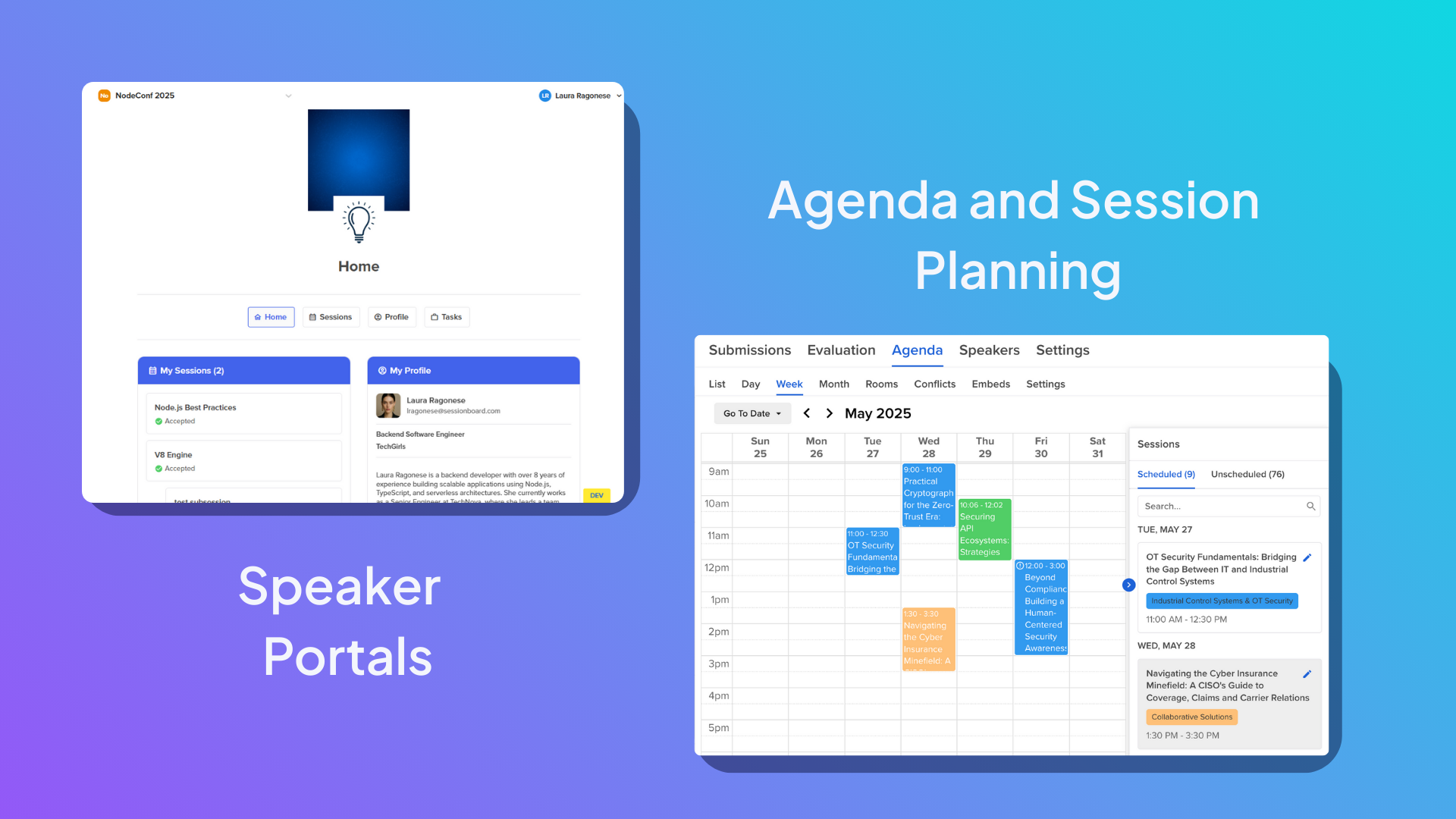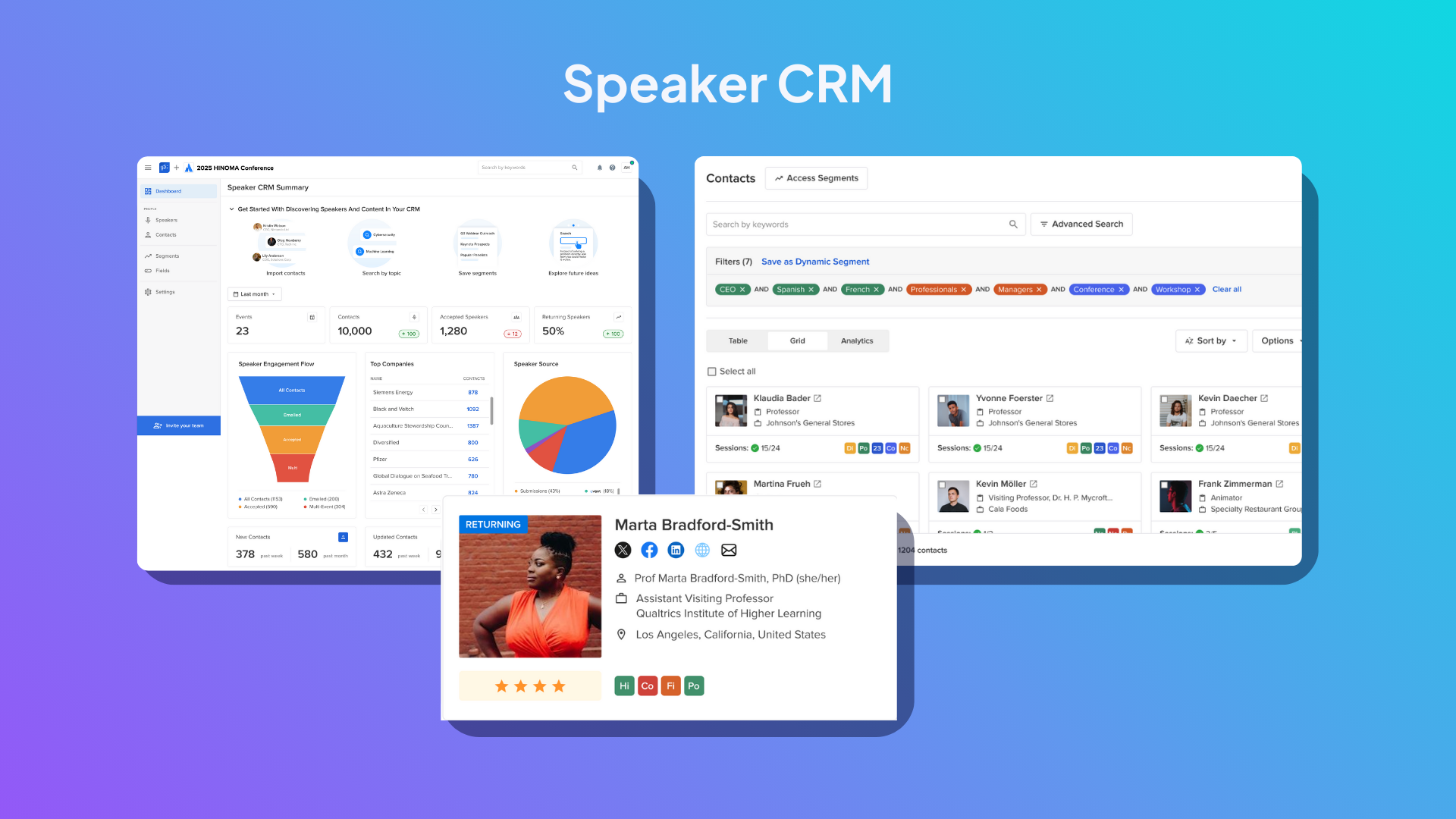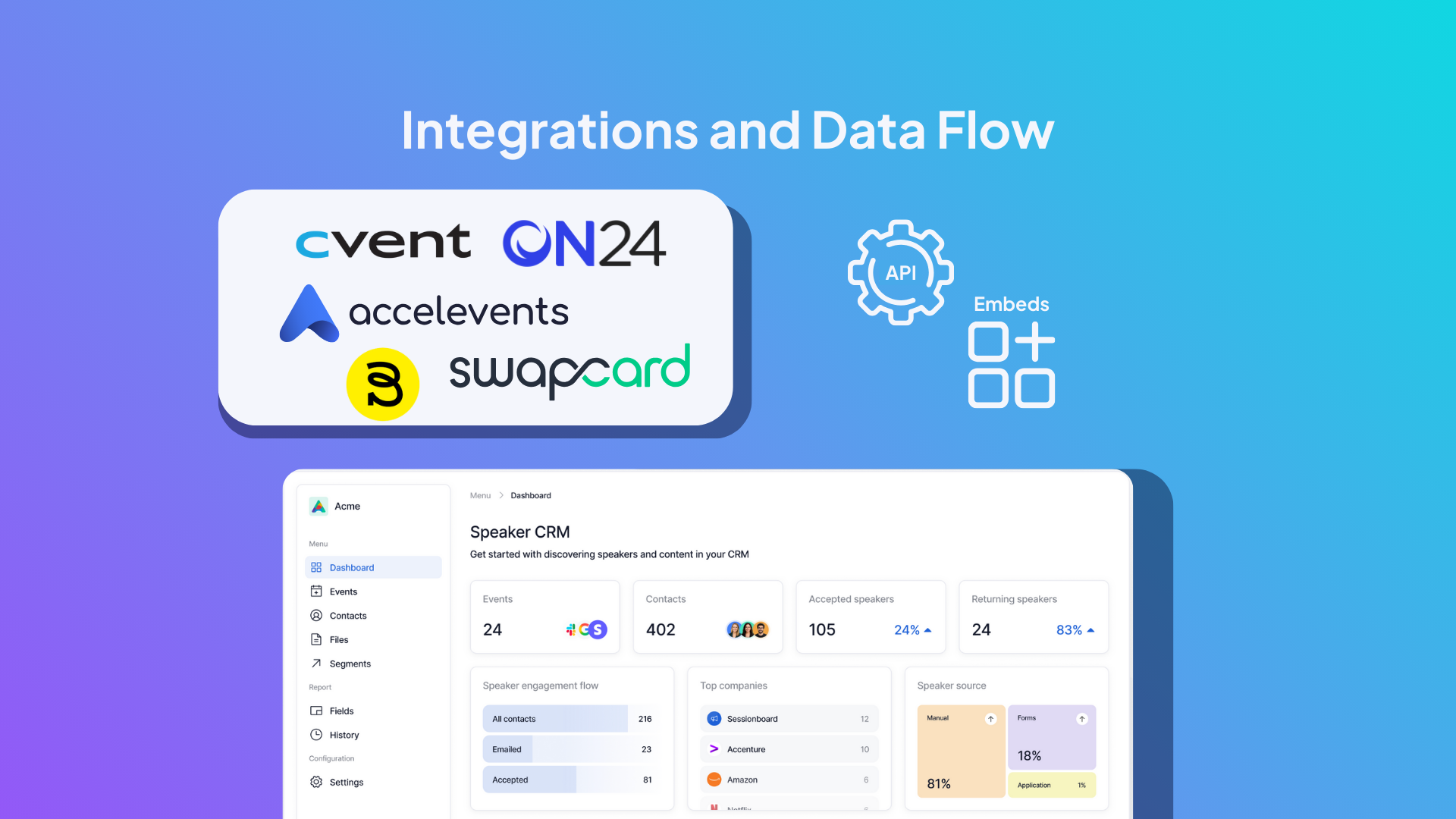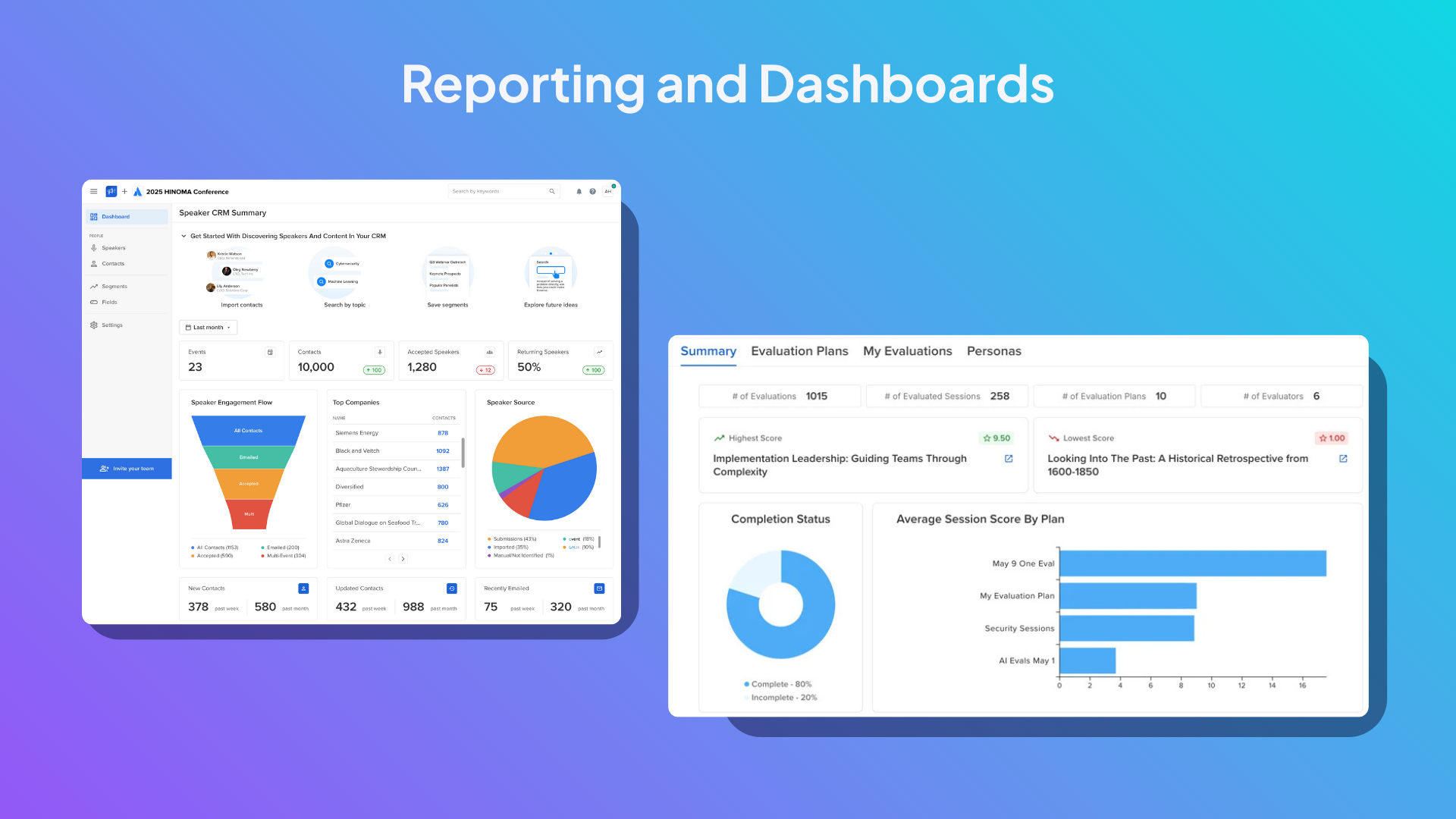Event Content Management RFP Template: How to Choose the Right Platform [Guide + Download]
Need a better way to evaluate event content platforms? Download our customizable RFP template to get started.

.JPG)
.png)
Selecting an event content management platform is a big decision. Whether you are moving away from spreadsheets and email or replacing outdated tools, the right platform will help you streamline speaker onboarding, manage session content, and turn your event data into a long-term asset.
An effective RFP (Request for Proposal) will help you compare vendors on the things that matter most: scalability, integrations, speaker experience, and the ability to manage content efficiently across multiple events.
To save you time, we created a practical RFP template designed for event professionals. Use it to make sure every vendor you evaluate can meet the needs of your content and programming workflows.
Event content is more than just session descriptions. It is an entire workflow that touches submissions, bios, evaluations, speaker communication, scheduling, and file sharing. And yet, many teams approach their search for new tools with only a loose checklist or a few priorities in mind.
The result? You end up sitting through demos that focus on surface-level features, while the real friction points go unaddressed. What looks great in a presentation may fall apart when you try to scale it across hundreds of speakers and dozens of sessions.
A well-written RFP brings structure to your process. It helps you define what really matters and stay focused on solutions that support your actual workflows.
It helps you:
• Clarify your must-have features and workflows before you talk to vendors
• Compare platforms objectively based on your team’s priorities
• Avoid hidden costs or gaps that slow your team down later
• Make sure the platform fits your entire content process, not just part of it
• Build stakeholder confidence with a clear, organized evaluation
Without a solid RFP, teams often get stuck in decision loops—revisiting options, second-guessing priorities, and struggling to compare tools that solve different problems. You waste time, stretch resources, and risk choosing a platform that creates more work instead of less.
A good RFP gives you clarity. It keeps your search aligned with your goals and helps you focus on what will actually make your next event easier to run and more successful.
Before you start collecting vendor responses, take a moment to define what “success” looks like for your team. For each requirement below, it’s helpful to include acceptance criteria—clear, specific explanations of how a feature should function, what problem it must solve, or what outcomes it should support.
This makes your RFP easier to compare, helps vendors focus their responses, and ensures your team is aligned on what matters most.
Here are the key sections to include. Each one will help you separate platforms purpose-built for event content from generic tools or outdated workarounds.

Your content process starts long before the event begins. From collecting proposals to building your schedule, you need tools that handle scale and complexity.
Ask about:
• Call for papers and custom submission forms
• Structured evaluation workflows and rubric-based scoring
• AI-assisted evaluation capabilities for faster, consistent reviews
• Agenda-building tools (calendar, track, room views)
• Task tracking and automated notifications for speakers and staff
This is where content quality is shaped. A strong submission and scheduling process sets the tone for the entire event.
A great speaker experience reduces back-and-forth, increases content accuracy, and builds stronger long-term relationships. If your platform doesn’t support this, your team will feel it in the inbox.
Ask about:
• Personalized speaker portals
• Shared access for co-presenters or assistants
• Built-in communications and reminders
• Year-round profile access for updates
These tools give speakers clarity and self-service options, while giving your team back their time.

Your speaker list is more than a one-time data dump — it’s a strategic asset. A CRM built for content unlocks reuse, personalization, and long-term value.
Ask about:
• Centralized speaker database with tagging and history
• Global search across events
• Content reuse tools for bios, sessions, and assets
• AI-powered content editing to improve clarity and consistency
Look for tools that help you repurpose speaker content across webinars, blog posts, and future events.

The best content tool works with your existing stack. Manual imports, mismatched fields, and lack of sync will slow you down.
Ask about:
• Native integrations (Cvent, ON24, Swapcard, Stova, etc.)
• API and embedded widgets for dynamic speaker and agenda views
• Continuous sync options to avoid duplicate work
• Bulk content export to support AV, marketing, and archival needs
Content is central to everything — make sure it flows cleanly between platforms.

Content is hard to manage without visibility. Real-time dashboards help you catch issues early, stay aligned, and answer stakeholder questions on the spot.
Ask about:
• Speaker and session status dashboards
• Evaluation progress tracking
• Audit logs and version history
These features help your team work with confidence and keep your content operations on track.
If you are building your RFP today, it is worth looking beyond the basics. Modern event content platforms needs to offer AI capabilities that save time, improve quality, and remove repetitive work.
Sessionboard Studio is our AI workspace for event teams. It brings together tools designed to reduce bottlenecks and give you more value from your content:
When these tools are built into the same platform that runs your submissions, evaluations, speaker management, and agenda, they are far more powerful than add-ons or disconnected AI experiments. They work with the data you already have, following your criteria, formats, and deadlines.
As you define your RFP requirements, consider whether the platform you choose can support this kind of automation without sacrificing security, accuracy or control. The right AI tools can make the difference between just getting through the work and transforming how your team operates.
.png)
Choosing the right platform does not just impact a single event. It shapes how your team collaborates, how your speakers experience your process, and how much value you are able to extract from your content over time.
When you rely on generic tools or patchwork solutions, it becomes harder to scale. Teams end up doing manual work that could be automated. Data gets trapped in spreadsheets. Speaker relationships become harder to maintain. And great content gets lost instead of reused.
A well-structured RFP helps you avoid those pitfalls. It ensures you are evaluating platforms based on what really matters—how they handle complexity, how they reduce repetitive work, and how they support the full lifecycle of event content.
With the right RFP, you can make a confident decision. One that sets your team up for success, gives your speakers a professional experience, and creates a foundation that grows with you. Not just for the next event, but for every one after that.
If you are rethinking how your team handles submissions, speakers, and content planning, let’s talk.
Our team is happy to walk you through how Sessionboard works—and more importantly, how it can work for you. This is not just a demo. It is a conversation about your process, your challenges, and where we can help.
Need a better way to evaluate event content platforms? Download our customizable RFP template to get started.
.png)
Selecting an event content management platform is a big decision. Whether you are moving away from spreadsheets and email or replacing outdated tools, the right platform will help you streamline speaker onboarding, manage session content, and turn your event data into a long-term asset.
An effective RFP (Request for Proposal) will help you compare vendors on the things that matter most: scalability, integrations, speaker experience, and the ability to manage content efficiently across multiple events.
To save you time, we created a practical RFP template designed for event professionals. Use it to make sure every vendor you evaluate can meet the needs of your content and programming workflows.
Event content is more than just session descriptions. It is an entire workflow that touches submissions, bios, evaluations, speaker communication, scheduling, and file sharing. And yet, many teams approach their search for new tools with only a loose checklist or a few priorities in mind.
The result? You end up sitting through demos that focus on surface-level features, while the real friction points go unaddressed. What looks great in a presentation may fall apart when you try to scale it across hundreds of speakers and dozens of sessions.
A well-written RFP brings structure to your process. It helps you define what really matters and stay focused on solutions that support your actual workflows.
It helps you:
• Clarify your must-have features and workflows before you talk to vendors
• Compare platforms objectively based on your team’s priorities
• Avoid hidden costs or gaps that slow your team down later
• Make sure the platform fits your entire content process, not just part of it
• Build stakeholder confidence with a clear, organized evaluation
Without a solid RFP, teams often get stuck in decision loops—revisiting options, second-guessing priorities, and struggling to compare tools that solve different problems. You waste time, stretch resources, and risk choosing a platform that creates more work instead of less.
A good RFP gives you clarity. It keeps your search aligned with your goals and helps you focus on what will actually make your next event easier to run and more successful.
Before you start collecting vendor responses, take a moment to define what “success” looks like for your team. For each requirement below, it’s helpful to include acceptance criteria—clear, specific explanations of how a feature should function, what problem it must solve, or what outcomes it should support.
This makes your RFP easier to compare, helps vendors focus their responses, and ensures your team is aligned on what matters most.
Here are the key sections to include. Each one will help you separate platforms purpose-built for event content from generic tools or outdated workarounds.

Your content process starts long before the event begins. From collecting proposals to building your schedule, you need tools that handle scale and complexity.
Ask about:
• Call for papers and custom submission forms
• Structured evaluation workflows and rubric-based scoring
• AI-assisted evaluation capabilities for faster, consistent reviews
• Agenda-building tools (calendar, track, room views)
• Task tracking and automated notifications for speakers and staff
This is where content quality is shaped. A strong submission and scheduling process sets the tone for the entire event.
A great speaker experience reduces back-and-forth, increases content accuracy, and builds stronger long-term relationships. If your platform doesn’t support this, your team will feel it in the inbox.
Ask about:
• Personalized speaker portals
• Shared access for co-presenters or assistants
• Built-in communications and reminders
• Year-round profile access for updates
These tools give speakers clarity and self-service options, while giving your team back their time.

Your speaker list is more than a one-time data dump — it’s a strategic asset. A CRM built for content unlocks reuse, personalization, and long-term value.
Ask about:
• Centralized speaker database with tagging and history
• Global search across events
• Content reuse tools for bios, sessions, and assets
• AI-powered content editing to improve clarity and consistency
Look for tools that help you repurpose speaker content across webinars, blog posts, and future events.

The best content tool works with your existing stack. Manual imports, mismatched fields, and lack of sync will slow you down.
Ask about:
• Native integrations (Cvent, ON24, Swapcard, Stova, etc.)
• API and embedded widgets for dynamic speaker and agenda views
• Continuous sync options to avoid duplicate work
• Bulk content export to support AV, marketing, and archival needs
Content is central to everything — make sure it flows cleanly between platforms.

Content is hard to manage without visibility. Real-time dashboards help you catch issues early, stay aligned, and answer stakeholder questions on the spot.
Ask about:
• Speaker and session status dashboards
• Evaluation progress tracking
• Audit logs and version history
These features help your team work with confidence and keep your content operations on track.
If you are building your RFP today, it is worth looking beyond the basics. Modern event content platforms needs to offer AI capabilities that save time, improve quality, and remove repetitive work.
Sessionboard Studio is our AI workspace for event teams. It brings together tools designed to reduce bottlenecks and give you more value from your content:
When these tools are built into the same platform that runs your submissions, evaluations, speaker management, and agenda, they are far more powerful than add-ons or disconnected AI experiments. They work with the data you already have, following your criteria, formats, and deadlines.
As you define your RFP requirements, consider whether the platform you choose can support this kind of automation without sacrificing security, accuracy or control. The right AI tools can make the difference between just getting through the work and transforming how your team operates.
.png)
Choosing the right platform does not just impact a single event. It shapes how your team collaborates, how your speakers experience your process, and how much value you are able to extract from your content over time.
When you rely on generic tools or patchwork solutions, it becomes harder to scale. Teams end up doing manual work that could be automated. Data gets trapped in spreadsheets. Speaker relationships become harder to maintain. And great content gets lost instead of reused.
A well-structured RFP helps you avoid those pitfalls. It ensures you are evaluating platforms based on what really matters—how they handle complexity, how they reduce repetitive work, and how they support the full lifecycle of event content.
With the right RFP, you can make a confident decision. One that sets your team up for success, gives your speakers a professional experience, and creates a foundation that grows with you. Not just for the next event, but for every one after that.
If you are rethinking how your team handles submissions, speakers, and content planning, let’s talk.
Our team is happy to walk you through how Sessionboard works—and more importantly, how it can work for you. This is not just a demo. It is a conversation about your process, your challenges, and where we can help.

Stay up to date with our latest news
See how real teams simplify speaker management, scale content operations, and run smoother events with Sessionboard.